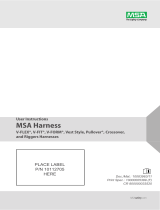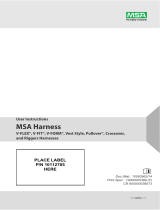
2
1.0 application
1.1.1 PURPOSE: Suspension harness used for Fall
Arrest (D-Ring connections A, Figure 2) and Work
Positioning (D-Ring connections B, Figure 2).
1.2.1 STANDARDS: Refer to life safety harness
information found in NFPA 1500, Standard on
Fire Department Occupational Safety and Health
Program, and NFPA 1983, Standard on Life Safety
Rope and Equipment for Emergency Services.
Figure 2 - Applications
A
A
B
2.0 system limitations & RequiRments
2.7.1 ENVIRONMENTAL HAZARDS: Do not expose the harness to flame or high temperature. Such exposure
could cause the harness to melt or burn and fail during use. Harnesses that meet the optional flame
resistance requirements specified in NFPA 1983 are designed for use in environments where exposure to
flame or high temperature could occur.
3.0 Donning anD use
3.9 DONNING AND FITTING THE SUSPENSION HARNESS: The ExoFit NEX™ Suspension Harness includes
leg straps for work positioning. Don the Full Body Suspension Harness using the following steps and the
corresponding images in Figure 3.
Step 1. Locate the front of the harness. The front has two D-rings. Lift up the harness and hold by the
shoulder straps. Ensure all straps are not twisted.
Step 2. With the front of the harness facing forward, step through the right side of the harness with
your right leg. Then, step through the left side of the harness with your left leg.
Grasp the right
shoulder strap and place it on the top of your right shoulder. Ensure that the straps are not
tangled and hang freely.
Step 3. Grasp the left shoulder strap and place it over your left shoulder.
The two D-rings will be
positioned on the front of your body if the harness has been donned properly.
Step 4. Grasp the tab of the buckle located at the bottom of the strap that you placed over your left
shoulder. Insert the tab into the receptor of the quick connect buckle on the left side of the
harness. You will hear a click when the tab engages properly.
note: Locking and unlocking the webbing lock prevents or allows the strap to slide
between the sliding bar and slot on the female end of the quick connect buckle. It does
not control engagement or disengagement of the buckle ends and will not affect the buckle
connection in the event of a fall.
Step 5. Grasp the waist-level strap ends on right and left sides of the harness. Pull both ends forward
until all slack is removed from the waist strap and the strap is comfortably tight around your
waist. Insert strap ends into the waist strap keeper loops on the right and left sides of the
harness.
Step 6. Reach between your legs and grasp the leg strap on your right side. Bring the strap up and
insert the tab of the buckle into the receptor of the buckle on the right side. You will hear a click
when the tab engages properly.
Step 7. Connect the right leg strap using the same procedure as in Step 6. To adjust the leg straps,
unlock
the webbing lock on the quick connect buckle and pull on the strap. A plastic end
keeper on the end of the strap will stop it from pulling completely out of the buckle. When the
strap is properly adjusted, lock
the webbing lock.
To release the buckle, press the silver-colored
tabs on the buckle towards each other with one hand, while pulling on the tab portion of the
buckle with the other hand.
Step 8. Adjustshoulderstrapstoasnugtusingthestrapadjustmentproceduredescribedbetween
Steps 4 and Step 5 on the following page. Left and right sides of the shoulder straps should be
adjusted to the same length and the upper front D-ring should be centered on your lower chest.
The back D-ring should be centered between your shoulder blades. Adjust the leg straps to a
snugt.Atleast3in.(8cm)ofwebbingmustextendpastthebuckleonthelegstraps.Adjust
thewaistbeltagainasnecessaryforasecure,comfortablet.













